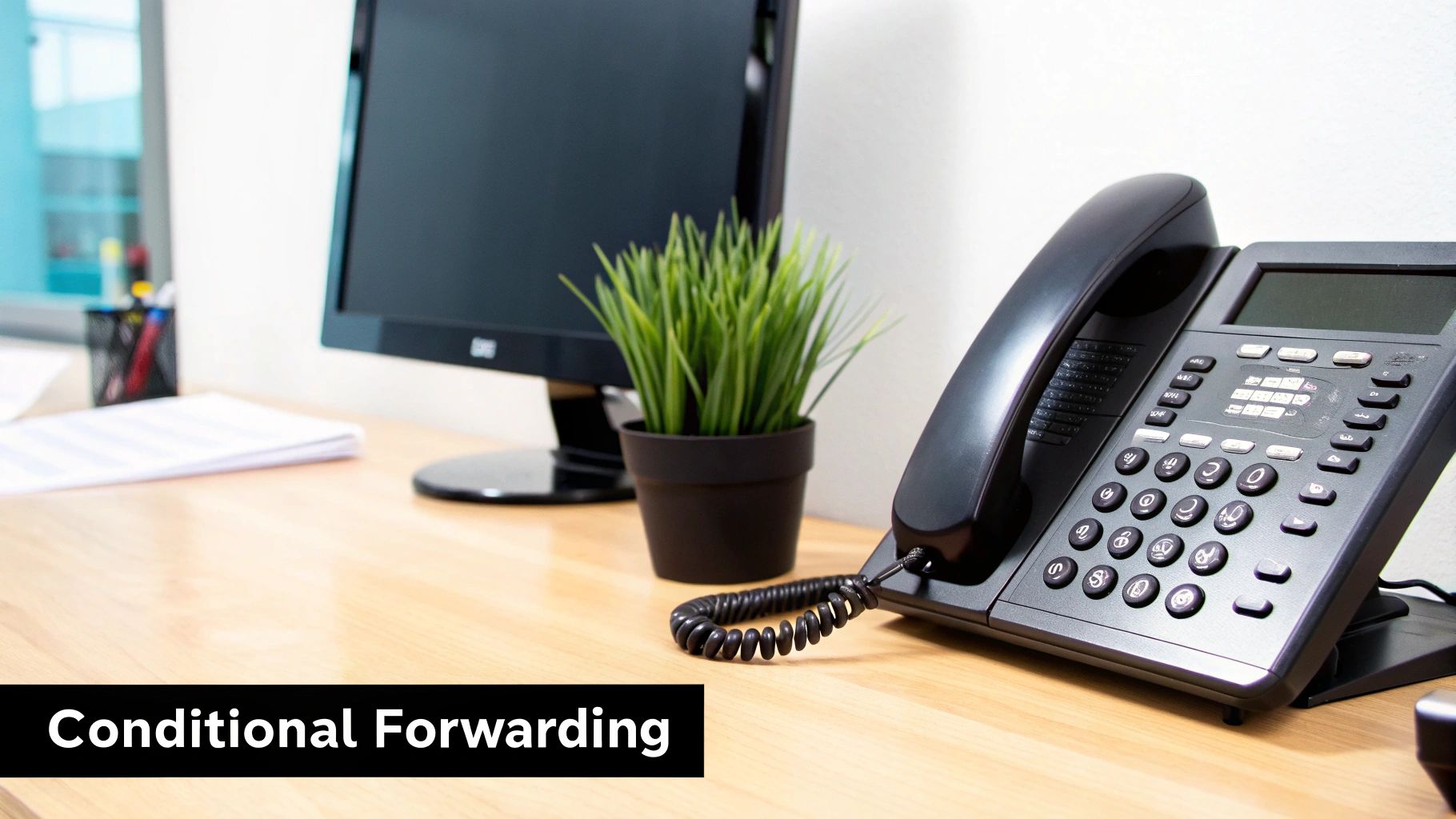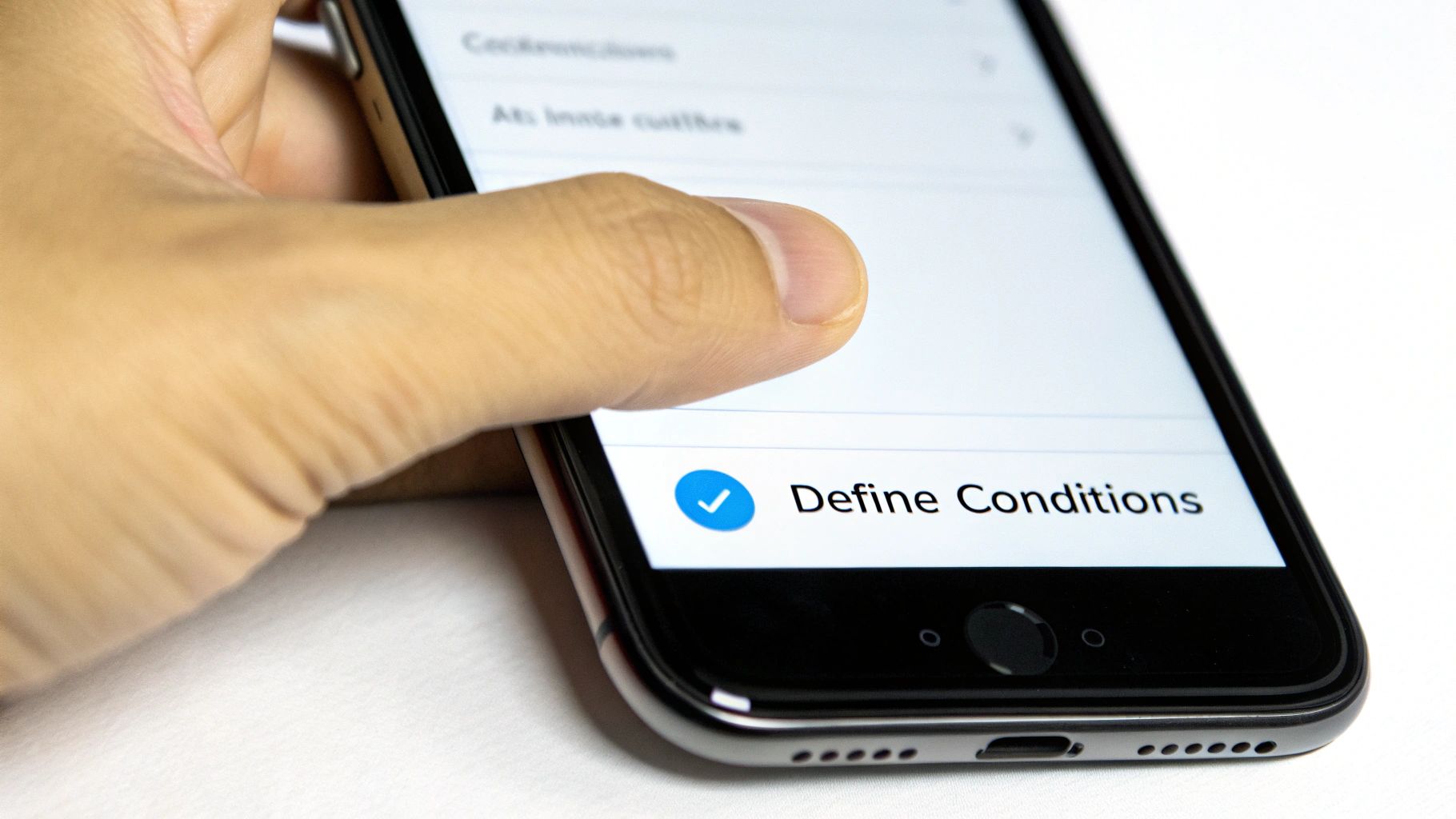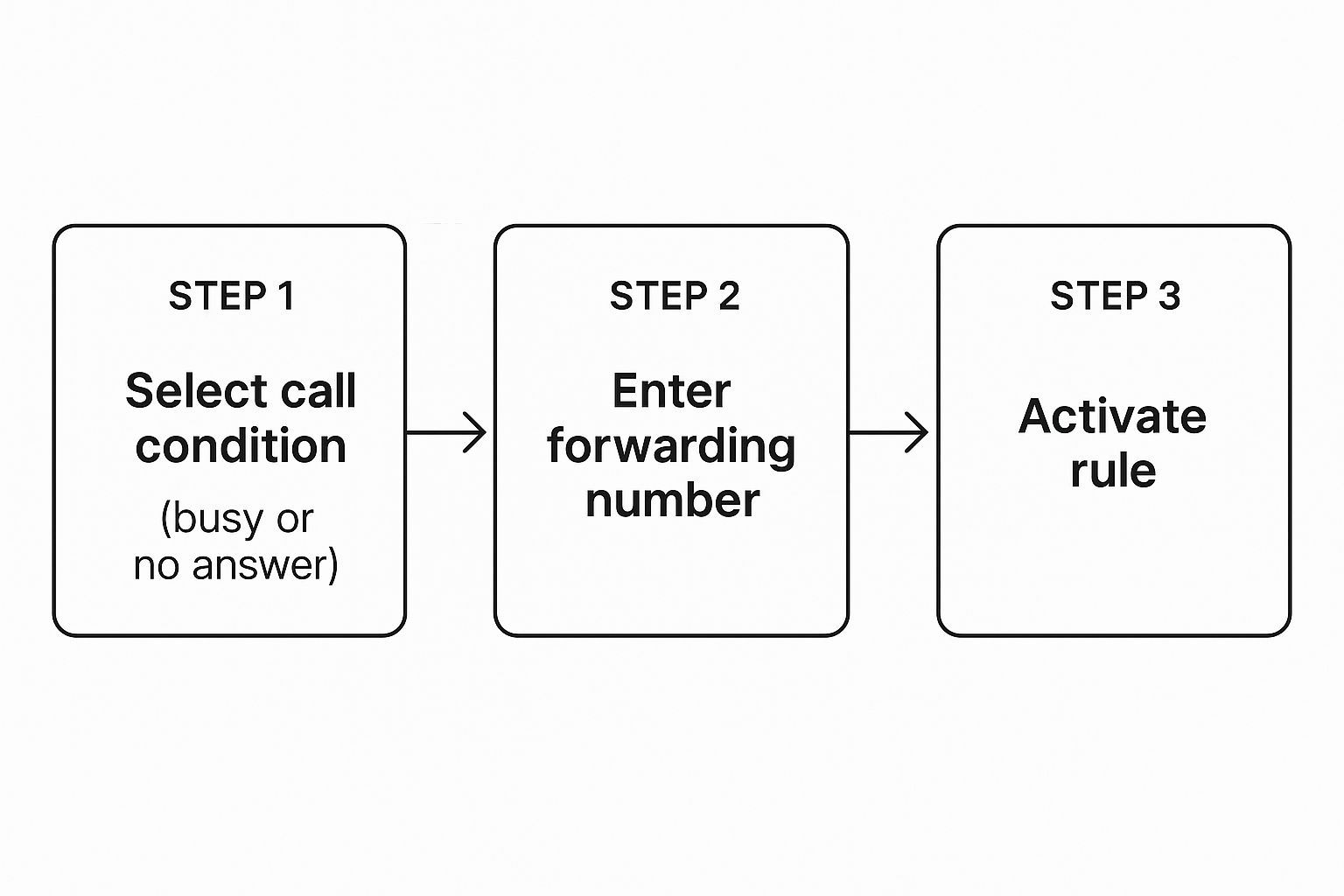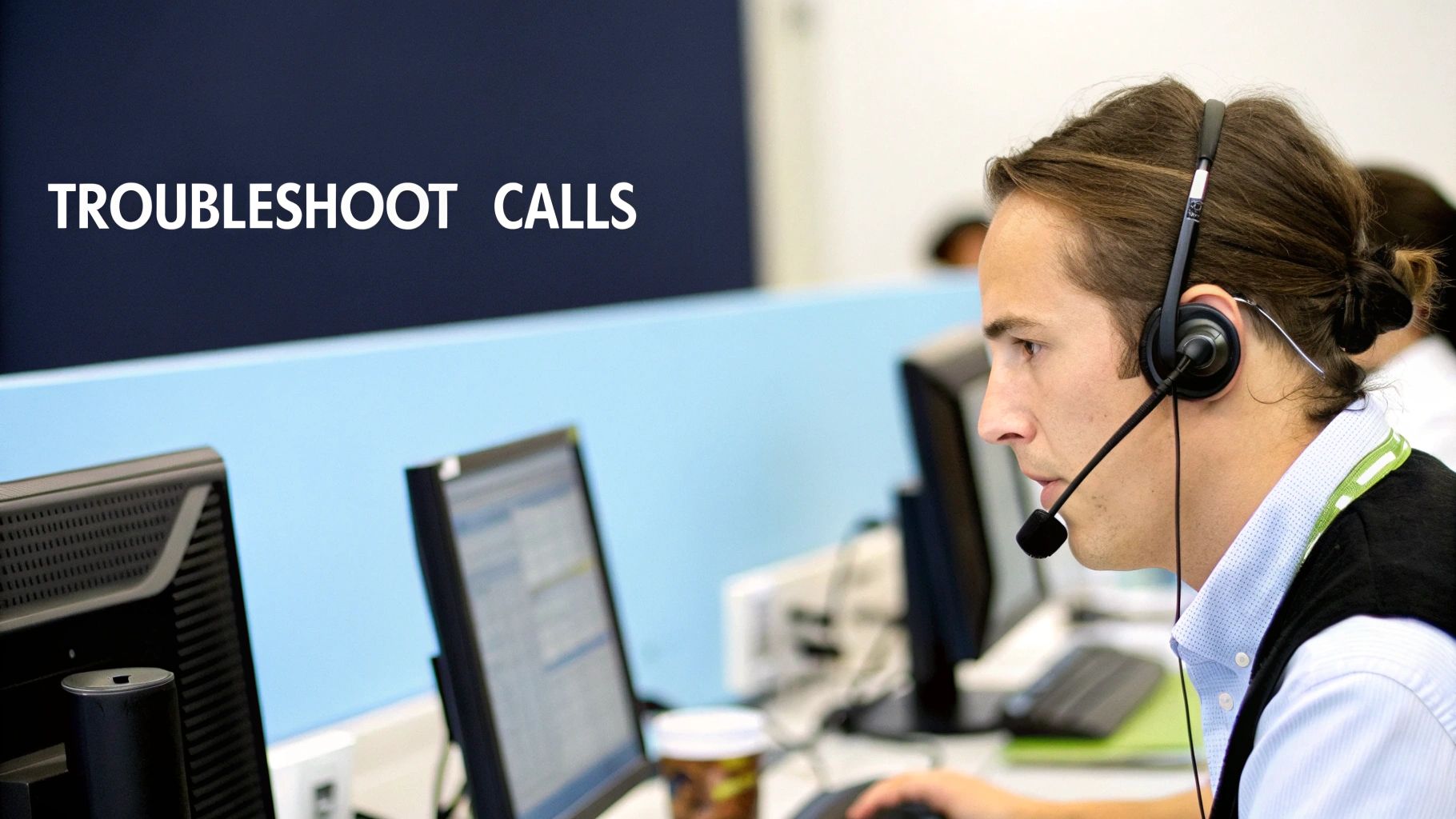Conditional call forwarding is a powerhouse feature that only kicks into gear when you need it most. Unlike the old-school method that just sends every single call to another number, this smarter approach gives you pinpoint control. It lets you decide exactly how calls should be handled based on what's happening in your day.
Think of conditional call forwarding as a savvy assistant for your phone line. Instead of using a sledgehammer to crack a nut, it operates on a set of rules you create. It's a total game-changer for any small business owner trying to juggle being available for customers while also getting actual work done.

The basic idea is to redirect calls only when a specific condition is met. This is completely different from unconditional call forwarding, which blindly sends all your incoming calls to another number without your primary phone ever even ringing. With conditional logic, your phone is still the main event—unless you're unavailable, that is.
Before diving into the setup, it's helpful to see how these two forwarding types stack up. They serve very different purposes, and knowing when to use each is key to effective call management.
This table clearly shows that conditional forwarding offers a more nuanced, flexible solution for day-to-day business operations.
Most modern phone systems, including My AI Front Desk, are built around three main triggers. Getting these right is the secret to building a call management strategy that actually works for you.
This level of control is precisely why so many businesses now depend on this feature. It's a simple, effective way to prevent missed opportunities. In fact, one report found that 86% of businesses use some form of call forwarding specifically to avoid losing calls and potential customers.
By setting up rules for these three scenarios, you create a powerful safety net. It guarantees that whether you're on another line, in a meeting, or on a flight, every single caller gets a professional and timely response. You can learn more about the benefits of AI-powered call forwarding for small businesses in our dedicated guide.
To really get why today's conditional call forwarding is so powerful, it helps to take a quick look back. It wasn't that long ago that rerouting a call was a clunky, all-or-nothing affair, tangled up in physical landlines and old-school operator switchboards. It was rigid, expensive, and totally out of reach for most small businesses.

The big shift happened with the move to VoIP (Voice over Internet Protocol). This took telephony out of the hardware closet and turned it into flexible, software-driven solutions. All of a sudden, advanced features that were once reserved for massive enterprises became accessible and affordable for practically everyone.
But this change wasn't just about new gadgets. It was driven by the real-world needs of modern business. As customer expectations soared and remote work became the norm, businesses needed far more control over their communications. The days of being chained to a desk phone were numbered.
The demand for smarter call management really exploded as workforces became more distributed. The old way of forwarding calls just didn't cut it anymore. By 2020, industry reports showed that over 70% of business telephony services included conditional forwarding as a standard feature. This trend took off as 60-70% of companies embraced remote or hybrid work models.
This evolution shows how today's smart systems are a direct response to real business challenges. They give companies the agility to manage a team spread across different locations, ensuring no customer call ever gets lost in the void.
Smart routing isn't just a "nice-to-have" feature anymore. It’s a core part of business continuity and delivering a great customer experience. It lets a solo entrepreneur project the image of a fully staffed office and helps teams stay connected, no matter where they're working from.
Platforms like My AI Front Desk are the result of this journey. By building conditional logic right into the call flow, they turn a simple phone number into an intelligent, responsive communication hub. You can get a deeper look into the mechanics in our guide on how AI call routing works. This path from manual patching to smart routing is what makes the powerful, practical tools we have today possible.
This is where the magic happens. Setting up your call forwarding conditional rules is how you turn a simple phone line into an intelligent, responsive system that works for you, not against you. Instead of a rigid, one-size-fits-all approach, you get to define specific triggers that send calls exactly where they need to go. No more missed opportunities.
With a platform like My AI Front Desk, you get direct control over three core conditions. Let's walk through how to configure each one to get the most out of your business communications.
We've all been there—you're on an important call, and another one comes in. The "When Busy" condition is your secret weapon against the dreaded busy signal. When you're already on the line, any new incoming call is instantly rerouted to a number you've chosen.
This is perfect for small teams where a colleague can pick up the slack. Or, you could send the caller to a dedicated assistant. The bottom line? Your clients get a seamless experience and never feel like they're being ignored.
The "When Unanswered" rule is the safety net for those times you just can't get to the phone. Maybe you're in a quick meeting or just stepped away from your desk for a moment. You can set a specific ring duration—say, 15 or 20 seconds. If you don't answer within that window, the call automatically forwards.
Where does it go? That's up to you. It could be your voicemail, an AI receptionist, or another team member's line. It’s a simple but powerful way to make sure every caller gets an answer.
This infographic breaks down just how simple it is to set up these rules.

As you can see, creating a powerful call flow is a logical process that keeps you in the driver's seat.
Last but not least, the "When Unreachable" trigger is your ultimate backup plan. If your phone is off, in airplane mode, or out of service, all calls are immediately forwarded to your designated number. This is absolutely essential for maintaining a professional image, even when you're completely offline during travel or after hours.
By mastering these three settings, you're not just forwarding calls—you're building a truly resilient communication system. It’s important to understand the difference between simple forwarding and provisioning a new number. You can explore the key differences between call forwarding and number provisioning to see what's best for your business.
The configuration dashboard itself is designed to be completely intuitive. You can easily toggle rules, pop in forwarding numbers, and fine-tune the settings until you have a system that works perfectly for your unique needs.
Knowing the rules is one thing, but seeing conditional call forwarding in action is where its value really clicks. It’s time to move past the technical stuff and look at how actual businesses use these settings to solve real-world problems. This is how you build a more professional and responsive front for your customers.
Picture a solo consultant who’s constantly jumping into client meetings. When she's focused on a presentation, she can't answer her phone, but she absolutely can't afford to miss a new lead. She sets up a "When Busy" rule. Now, any call that arrives while her line is tied up gets instantly routed to her virtual assistant.
The result? Every single caller talks to a real person, new appointments get booked, and she doesn't lose out on new business. It’s a simple tweak that makes her one-person show feel like a polished, always-on operation.
The possibilities here are pretty much endless and can be shaped to fit any business. Let's look at a few common situations where one smart rule can make all the difference.
These examples drive home a key point: conditional forwarding isn't just about dumping a call somewhere else. It’s about building intelligent pathways that react to your availability in real-time, ensuring every customer interaction is a good one.
Here’s another classic problem and how to solve it with a simple forwarding rule.
The Problem: A small marketing agency has one main business line. But the team often steps away for brainstorming sessions or lunch breaks, leaving the phone ringing off the hook.
The Solution: They put a "When Unanswered" rule in place. If the phone rings for 20 seconds with no answer, the call automatically forwards to a "hunt group." This feature rings each team member's mobile phone in a sequence until someone picks up. It’s a brilliant setup that guarantees a knowledgeable person is always reachable, even if no one's physically in the office.
This kind of strategy is a game-changer for remote teams. You can dive deeper into this in our guide to remote call forwarding for essential business communication. By simply thinking through your daily workflow and spotting where calls might get dropped, you can use these rules to build a truly reliable communication system.
Alright, once you've got the basics of conditional call forwarding handled, it's time to build a truly intelligent communication system. Moving beyond the standard "busy" or "unanswered" rules is where you unlock some serious professionalism and efficiency. These advanced strategies turn your phone system from a simple tool into a proactive asset that actually works with you.

One of the most powerful tactics I've seen clients use is sequential ringing. You might also hear it called a hunt group. Instead of just sending a missed call to one number, this feature tries a whole list of numbers, one after another, in an order you decide. The call rings the first number, and if there's no answer, it automatically jumps to the next one, and so on, until someone finally picks up.
This is a game-changer for teams. It guarantees that if the primary contact is tied up, the call doesn't die—it finds the next available expert. Trust me, it dramatically increases the odds that your customers will get to talk to a real person.
Another pro-level move is setting up time-based routing. This lets you create completely different forwarding rules that change depending on the time of day or day of the week. For example, during business hours, an unanswered call could ring a colleague. But after 5 PM or on weekends, you can have it go straight to your AI receptionist or a dedicated after-hours voicemail.
On top of that, I always recommend using a dedicated virtual number for your forwarding. Instead of plastering your personal cell number everywhere, you use a separate business number as the destination. This approach gives you a few critical advantages:
By layering these strategies—sequential ringing for team coverage, time-based routing for work-life balance, and a virtual number for privacy—you create a truly robust and scalable system. This approach ensures you never miss a critical call while maintaining complete control over your availability and personal time.
When you're setting up a new call management system, a few questions always seem to pop up. I get it—you want to feel confident that your calls are going exactly where they need to, every single time. Let's clear up some of the most common queries I hear about call forwarding conditional rules so you can get your setup just right.
This is a big one. The short answer is yes, absolutely. With a modern VoIP system like My AI Front Desk, you can route calls to almost any number in the world.
The key thing to remember, though, is cost. Forwarding to a number outside your home country almost always comes with higher per-minute rates than domestic calls. It’s a fantastic feature for global teams, but always double-check the pricing with your provider to avoid any billing surprises.
"Does forwarding still work if my phone is dead?" I hear this all the time, and the answer is a resounding yes. This is the whole point of the "When Unreachable" condition.
Think of it this way: the forwarding decision doesn't happen on your phone. It happens at the network level. The moment the system detects that your device is powered off, out of a service area, or simply not picking up, it instantly reroutes the call to your designated backup number. Your phone's status doesn't matter.
In a cloud-based system, changes are practically instantaneous. The second you hit "save" on a new rule—whether you're changing a forwarding number or tweaking the ring duration—the system updates in real-time. The very next call that comes through will follow your new instructions. No waiting, no lag.
And what about costs? For standard domestic numbers, call forwarding is typically baked into your plan. The only time you might see extra charges (besides international forwarding) is if you route calls to a number that has its own usage-based fees, like a premium third-party answering service.
The most important thing to grasp is that modern call forwarding is built for reliability and speed. Your rules are active the moment you create them, and the "unreachable" trigger is a rock-solid safety net that works no matter what your phone is doing.
Getting these details straight from the start helps you build a forwarding strategy that’s not just effective, but also perfectly aligned with your budget. You’ll have peace of mind knowing you're not missing calls or racking up unexpected charges.
Ready to build an intelligent, responsive call system that never misses a lead? My AI Front Desk combines powerful conditional call forwarding with an AI receptionist to ensure every caller gets a professional, immediate response. Explore our features and start your free trial today.
Start your free trial for My AI Front Desk today, it takes minutes to setup!








